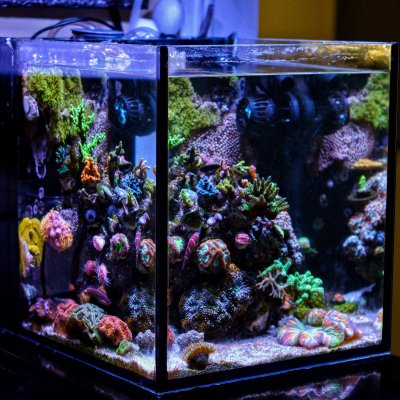Big or Small? Picking Out Your First Reef Tank
So you’ve decided you want to join the hobby of reef keeping…Now what? Whether you are new to the hobby or adding your 15th tank, tank size is something every reefer needs to consider before making a new purchase. Tank size is more than just the logistical concerns of what will fit in your home and is something you’ll want to really think about before making your first purchase. Here are just a few of the things to consider before bringing home your first tank.
Type of fish you want. When selecting your first tank, you need to consider what type of fish you are hoping to keep. Each type of fish needs a varying amount of tank space to accommodate their swimming needs. For example, you can have a pair of clowns live very happily in a nano tank while a hippo tang requires the tank be a minimum of six feet long and 180 gallons (liveaquaria). Make sure you are researching the type of fish you are hoping to have before buying your tank to avoid being disappointed that you can’t house your dream fish. You will also want to consider the amount of fish you are hoping to have in your tank. Overstocking your tank can cause unnecessary stress on your fish and could lead to increased aggression. By keeping your fish needs in mind you are keeping your fish happy and healthy!
Available spacing for ideal location. You will want to pick the ideal location for your tank. You will want to find an ideal location where your tank can be appreciated by your family and visitors. Not everyone’s spouse is willing to allow a main room in the house to be converted into the fish room, but I hope some of you are this lucky! Once you’ve identified where you want your tank you will want to measure to accommodate tank, stand lights and sump. You will be spending a lot of time working on and admiring your tank, so finding the perfect location is an important step in selecting your first reef tank size.
Cost and price range for total set up. This is a big one in the saltwater industry. Cost of your first set up is significantly more than just the initial price of the tank itself. You’ll want to consider all of the extras when adding a larger tank such as amount of live rock needed. If cost is something you are worried about, it would be better in the long run to save up for the tank of your dreams versus making a smaller purchase that is in your immediate budget. Although it may be in the best interest for some new reefers to start small to get a feel for what the hobby is all about. Just be aware that you might find yourself looking to upgrade within a short amount of time.
Maintenance. A reef tank takes weekly maintenance. The larger your tank, the more time will be needed to maintain your little piece of the ocean. Reef tanks take time and you’ll want to consider how much extra time you have to devote to water changes and cleaning. If you aren’t sure how much time you’re going to have to maintain your tank, you may want to consider a smaller option in order be able to provide your tank with the attention it deserves.
Recommendations.
Unless you really love the look of a nano tank as a new reefer I would recommend a tank size between 30 and 125 gallons. Also be aware the smaller your tank size the more challenging it is to keep your water parameters stable. Anything above my suggested size might be overwhelming to a new reefer.
Picking out the size and shape of your first tank is your first big step in reefing. Whether you go big or small, your tank will likely be part of your home for years to come. Take some time to think about what the best fit will be for your reefing needs.













